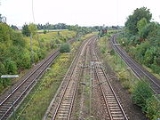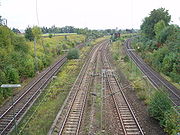
Augsburg–Welden railway
Encyclopedia
>
The Augsburg–Welden railway (also referred to in German as the Weldenbahn or "Welden railway") was a branch line in southern Germany that ran from the city of Augsburg
to Welden
. In its narrowest sense it was a single-tracked branch line, that initially branched off in Augsburg-Oberhausen and, from 1933, from the Augsburg–Ulm main line station at Augsburg-Hirblinger Strasse.
 The Royal Bavarian State Railways
The Royal Bavarian State Railways
opened the 23 km long route from Augsburg to Oberhausen
on 5 December 1903; all trains began and ended at Augsburg Hauptbahnhof
. The volume of traffic on the route entirely fulfilled the expectations of the operator and, in 1909, the line was classed as the second most profitable Lokalbahn in Bavarian Swabia
.
Between 1929 and May 1933 the main line from Augsburg to Ulm
was relayed west of Augsburg-Oberhausen for a length of 7.5 km as part of the electrification
of the railway. In doing so the branch off point for the Weldenbahn was moved to the station at Augsburg-Hirblinger Strasse. From there it ran at that time between the two tracks of the main line as far as Neusäß
, where it rejoined the original trackbed.
Since 1949 there has been a bus connexion from Augsburg to Welden in parallel with the railway. In the following decades this, together with the growth of private motor vehicles, resulted in a decline in traffic on the railway line. From the summer timetable of 1975 there were no services at all on Saturday afternoons, Sundays or public holidays. On 21 January 1986 passenger services were withdrawn on the basis of a DB proposal agreed on 17 July 1985 by the management der DB.
Goods traffic, which was always meagre, ceased between Lohwald and Welden in the first half of 1986, and the track was dismantled on this section as early as summer 1986. The dye factory of Keim in Lohwald was supplied until July 1989 by rail, but after the firm moved to Diedorf the remaining section of line was closed and lifted. Only in the area of the old station at Neusäß and between Neusäß and Augsburg-Hirblinger Strasse are remains of the tracks still to be seen.
The Augsburg–Welden railway (also referred to in German as the Weldenbahn or "Welden railway") was a branch line in southern Germany that ran from the city of Augsburg
Augsburg
Augsburg is a city in the south-west of Bavaria, Germany. It is a university town and home of the Regierungsbezirk Schwaben and the Bezirk Schwaben. Augsburg is an urban district and home to the institutions of the Landkreis Augsburg. It is, as of 2008, the third-largest city in Bavaria with a...
to Welden
Welden
Welden is a community in the Augsburg district of Bavaria, Germany, and is the seat of the commune of Welden. Since the local government reform in 1978 it comprises Welden, Reutern and Ehgatten.-Geography:...
. In its narrowest sense it was a single-tracked branch line, that initially branched off in Augsburg-Oberhausen and, from 1933, from the Augsburg–Ulm main line station at Augsburg-Hirblinger Strasse.
History

Royal Bavarian State Railways
As a nation-state, Germany did not come into being until the creation of the German Empire in 1871 from the various German-speaking states such as Prussia, Bavaria, Saxony, Baden and Württemberg. By then each of the major states had formed its own state railway and these continued to remain...
opened the 23 km long route from Augsburg to Oberhausen
Oberhausen
Oberhausen is a city on the river Emscher in the Ruhr Area, Germany, located between Duisburg and Essen . The city hosts the International Short Film Festival Oberhausen and its Gasometer Oberhausen is an anchor point of the European Route of Industrial Heritage. It is also well known for the...
on 5 December 1903; all trains began and ended at Augsburg Hauptbahnhof
Augsburg Hauptbahnhof
is the Hauptbahnhof for the Bavarian city of Augsburg, situated in southern Germany.The station has one of the oldest still existing station halls in Germany, which was built from 1843 to 1846 after plans by architect Eduard Rüber. It was reconstructed in 1869 according to Friedrich Bürklein's plans...
. The volume of traffic on the route entirely fulfilled the expectations of the operator and, in 1909, the line was classed as the second most profitable Lokalbahn in Bavarian Swabia
Swabia (administrative region)
Swabia is one of the seven administrative regions of Bavaria, Germany.- Geography :Swabia is located in southwest Bavaria. It was formed out of the part of the historic region of Swabia which was annexed by Bavaria in 1803. It was once formally ruled by dukes of the Hohenstaufen dynasty. During...
.
Between 1929 and May 1933 the main line from Augsburg to Ulm
Ulm
Ulm is a city in the federal German state of Baden-Württemberg, situated on the River Danube. The city, whose population is estimated at 120,000 , forms an urban district of its own and is the administrative seat of the Alb-Donau district. Ulm, founded around 850, is rich in history and...
was relayed west of Augsburg-Oberhausen for a length of 7.5 km as part of the electrification
Electrification
Electrification originally referred to the build out of the electrical generating and distribution systems which occurred in the United States, England and other countries from the mid 1880's until around 1940 and is in progress in developing countries. This also included the change over from line...
of the railway. In doing so the branch off point for the Weldenbahn was moved to the station at Augsburg-Hirblinger Strasse. From there it ran at that time between the two tracks of the main line as far as Neusäß
Neusäß
Neusäß is a municipality in the district Augsburg, Bavaria, Germany. The town lies on the Schmutter river and borders the city of Augsburg. , the city had 21,914 inhabitants.-Town districts:* Alt-Neusäß* Hainhofen* Hamel* Westheim* Schlipsheim...
, where it rejoined the original trackbed.
Since 1949 there has been a bus connexion from Augsburg to Welden in parallel with the railway. In the following decades this, together with the growth of private motor vehicles, resulted in a decline in traffic on the railway line. From the summer timetable of 1975 there were no services at all on Saturday afternoons, Sundays or public holidays. On 21 January 1986 passenger services were withdrawn on the basis of a DB proposal agreed on 17 July 1985 by the management der DB.
Goods traffic, which was always meagre, ceased between Lohwald and Welden in the first half of 1986, and the track was dismantled on this section as early as summer 1986. The dye factory of Keim in Lohwald was supplied until July 1989 by rail, but after the firm moved to Diedorf the remaining section of line was closed and lifted. Only in the area of the old station at Neusäß and between Neusäß and Augsburg-Hirblinger Strasse are remains of the tracks still to be seen.
Present situation
The name and trackbed of the Weldenbahn remain today in the form of a cycle path; and the tarmac route is particularly liked by inline skaters. Public transports services today ar provided by the regional bus lines 501 (Augsburg-Neusäß-Aystetten-Welden) and 500 (Augsburg-Neusäß-Aystetten) within the Augsburg Transport Network ( Augsburger Verkehrs-Verein or AVV) zur Verfügung. The lines are operated by Regionalbus Augsburg GmbH (RBA).See also
- Royal Bavarian State RailwaysRoyal Bavarian State RailwaysAs a nation-state, Germany did not come into being until the creation of the German Empire in 1871 from the various German-speaking states such as Prussia, Bavaria, Saxony, Baden and Württemberg. By then each of the major states had formed its own state railway and these continued to remain...
- Bavarian branch linesBavarian branch linesBavarian branch lines comprised nearly half the total railway network in Bavaria, a state in the southeastern Germany that was a kingdom in the days of the German Empire...
- List of closed railway lines in Bavaria
Sources
External links
- Photograph of Welden station
- There is a relevant English-language forum at Railways of Germany

